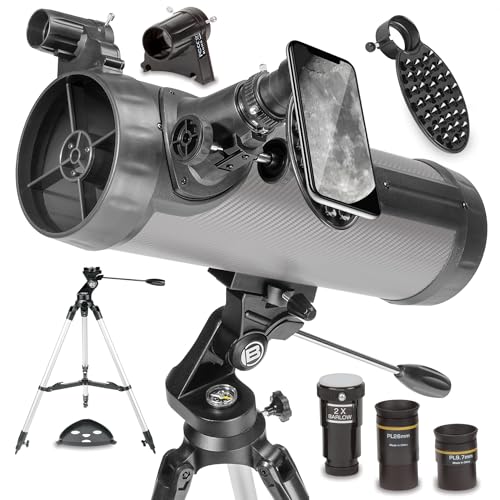For years, I dreamt of exploring the night sky, of witnessing the majesty of planets and distant nebulae. The thought of gazing at Saturn’s rings or Jupiter’s swirling clouds filled me with a childlike wonder. But the intimidating complexity of telescopes, coupled with often confusing specifications, kept me from taking the plunge. I knew a Celestron AstroMaster 76EQ Newtonian Telescope could have helped me overcome that initial barrier, bringing the universe closer. The fear of purchasing an inadequate instrument and becoming discouraged before even starting held me back.
- POWERFUL TELESCOPE FOR ASTRONOMY BEGINNERS: The AstroMaster 130EQ delivers sharp optics, a stable equatorial mount, and smooth manual controls, making it the top choice for beginners ready to explore...
- HIGH-QUALITY 130MM OPTICS: Enjoy views through the 130mm (5”) Newtonian reflector, which features high-quality aluminum and SiO₂ coatings and enough light-gathering ability to view all the best...
- SMOOTH, ACCURATE POINTING: Effortlessly aim and center your target using the two slow-motion control knobs for right ascension and declination whether you’re observing planets or deep-sky objects.
Choosing Your First Telescope: What to Consider
The world of telescopes can be overwhelming for newcomers. Deciding to buy a telescope means addressing a desire to explore the night sky, to observe celestial objects beyond what’s visible to the naked eye. The ideal customer is someone with a genuine curiosity about astronomy, willing to learn and invest some time in mastering the equipment. This telescope is great for someone who wants a relatively affordable entry point and appreciates a balance of features and ease of use. Those completely new to the hobby might benefit from a simpler, pre-aligned model. Experienced astrophotographers will likely want a more advanced setup with superior optics and tracking. Before buying any telescope, carefully consider your budget, your level of experience, and the types of celestial objects you’re most interested in observing. Think about the size and portability of the telescope, as well as the type of mount—equatorial mounts, while more challenging to learn, offer superior tracking capabilities.
- 【130mm Large Aperture】Large aperture 130mm telescope, high resolution, good light collecting ability, imaging brighter, more suitable for the observation of deep space celestial objective.
- 150mm Large Aperture: Capture bright, clear, and detailed views of the night sky with a 150mm aperture and 650mm focal length. Its powerful light-gathering ability delivers sharp images—perfect for...
- LARGE APERTURE: This Newtonian telescope has a 114mm aperture for exploring the Moon, planets and deep sky objects.
Introducing the Celestron AstroMaster 76EQ
The Celestron AstroMaster 76EQ Newtonian reflector telescope promises a powerful and user-friendly introduction to amateur astronomy. It arrives with two eyepieces (20mm and 10mm), a StarPointer red dot finderscope, an adjustable tripod, and a free download of astronomy software. Compared to other entry-level telescopes, its 76mm aperture offers significantly improved light-gathering capabilities, revealing more detail in celestial objects. However, it’s not designed for astrophotography and its limitations will be noticeable for experienced observers. Here’s a quick breakdown:
Pros:
* Relatively easy setup and use.
* Affordable price point for the features included.
* Decent light-gathering ability for its size.
* Compact and portable for travel.
* Includes useful accessories.
Cons:
* Not ideal for astrophotography.
* Equatorial mount can be challenging for complete beginners.
* Optical quality isn’t as high as more expensive models.
* Some users have reported quality control issues with certain components.
Exploring the Features and Benefits
The Equatorial Mount: Mastering Celestial Tracking
The AstroMaster 76EQ’s equatorial mount is a key feature. While initially intimidating, it’s essential for tracking celestial objects as the Earth rotates. The two slow-motion control knobs allow for precise adjustments, keeping your target centered in the eyepiece. Learning to polar align the mount is crucial for optimal tracking, and while it requires some patience, the improved stability it provides is well worth the effort. I found that using online tutorials and practice significantly improved my ability to use this aspect of the telescope.
The StarPointer Red Dot Finder: Simplifying Target Acquisition
The red dot finderscope is a game-changer, especially for beginners. It simplifies the process of locating celestial objects, significantly reducing frustration. Unlike traditional finderscopes, the red dot provides a simple, illuminated dot that overlays your field of view. This allows you to aim the telescope roughly at your target and then make small adjustments until the object is centered in the main eyepiece. While the initial alignment can be a little fiddly, once set, it is immensely useful and makes finding planets and brighter deep-sky objects much easier.
The Eyepieces and Optics: Unveiling Celestial Details
The included 20mm and 10mm eyepieces provide different magnifications, allowing you to observe a variety of objects. The 20mm eyepiece offers a wider field of view, ideal for locating targets and observing larger objects like the Moon. The 10mm eyepiece provides higher magnification, suitable for planets and closer views of lunar features. While some users find the included eyepieces to be adequate, many experienced observers upgrade to higher quality eyepieces for better clarity and contrast. The quality of the optics is adequate for beginners, however, and a key selling point for entry level telescopes, showing clear, sharp views.
Assembly and Portability: A User-Friendly Experience
Assembly of the Celestron AstroMaster 76EQ is straightforward; the instructions are clear, and the process is relatively quick. The telescope is lightweight and reasonably compact, making it easy to transport to different locations for observing. This portability is a considerable advantage, especially for those who like to explore different observing sites.
Community Voices: User Experiences
I researched extensively before purchasing my telescope and found many online reviews, which provided invaluable insight. The most common praise centered on the telescope’s easy assembly, intuitive red dot finder, and the surprising detail visible, especially on the Moon and planets. Many beginners reported successfully observing Jupiter’s moons and Saturn’s rings. Others highlighted the relatively easy-to-use equatorial mount after an initial learning curve. Some users did report issues with collimation and the occasional poorly aligned telescope but these cases seemed to be exceptions, rather than the rule. Overall, user feedback painted a picture of a capable instrument, perfect for those beginning their astronomical exploration.
Reaching for the Stars: A Final Verdict
The Celestron AstroMaster 76EQ Newtonian Telescope addresses the problem of inaccessibility to the wonders of space for beginners. The fear of investing in a complicated and potentially disappointing instrument is a significant obstacle to entry, but this telescope largely resolves that issue. Its ease of setup, intuitive red-dot finder, and portability make it an excellent entry point for anyone curious to learn about and enjoy astronomy. The equatorial mount, while requiring some learning, vastly improves the viewing experience compared to simpler altazimuth mounts. To unlock the universe’s wonders, click here to discover the Celestron AstroMaster 76EQ and embark on your own celestial adventure.
Last update on 2025-10-27 / Affiliate links / Images from Amazon Product Advertising API




